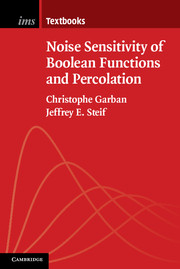Book contents
- Frontmatter
- Dedication
- Contents
- Preface
- Notations
- 1 Boolean functions and key concepts
- 2 Percolation in a nutshell
- 3 Sharp thresholds and the critical point for 2-d percolation
- 4 Fourier analysis of Boolean functions (first facts)
- 5 Hypercontractivity and its applications
- 6 First evidence of noise sensitivity of percolation
- 7 Anomalous fluctuations
- 8 Randomized algorithms and noise sensitivity
- 9 The spectral sample
- 10 Sharp noise sensitivity of percolation
- 11 Applications to dynamical percolation
- 12 For the connoisseur
- 13 Further directions and open problems
- References
- Index
6 - First evidence of noise sensitivity of percolation
Published online by Cambridge University Press: 18 December 2014
- Frontmatter
- Dedication
- Contents
- Preface
- Notations
- 1 Boolean functions and key concepts
- 2 Percolation in a nutshell
- 3 Sharp thresholds and the critical point for 2-d percolation
- 4 Fourier analysis of Boolean functions (first facts)
- 5 Hypercontractivity and its applications
- 6 First evidence of noise sensitivity of percolation
- 7 Anomalous fluctuations
- 8 Randomized algorithms and noise sensitivity
- 9 The spectral sample
- 10 Sharp noise sensitivity of percolation
- 11 Applications to dynamical percolation
- 12 For the connoisseur
- 13 Further directions and open problems
- References
- Index
Summary
In this chapter, our goal is to collect some of the facts and theorems we have seen so far in order to conclude that percolation crossings are indeed noise sensitive. Recall from the “BKS” Theorem (Theorem 1.21) that it is enough for this purpose to prove that influences are “small” in the sense that ΣkIk(fn)2 goes to 0. If we want to use only what we have actually proved in this book, namely Proposition 5.6, then we need to demonstrate (5.6) in this proposition.
In the first section, we deal with a careful study of influences in the case of percolation crossings on the triangular lattice. Then, we treat the case of ℤ2, where conformal invariance is not known. Finally, we speculate to what “extent” percolation is noise sensitive.
This whole chapter should be considered somewhat of a “pause” in our program, where we take the time to summarize what we have achieved so far in our understanding of the noise sensitivity of percolation, and what remains to be done if one wishes to obtain the exact “noise sensitivity exponent” as well as the existence of exceptional times for dynamical percolation.
Bounds on influences for crossing events in critical percolation on the triangular lattice
6.1.1 Setup
Fix a, b > 0, let us consider some rectangle [0, a·n]×[0, b·n], and let Rn be the set of hexagons in T that intersect [0, a·n]×[0, b·n]. Let fn be the event that there is a left-to-right crossing event in Rn. (This is the same event as in Example 1.22 in Chapter 1, but with ℤ2 replaced by T.) By the RSW Theorem 2.1, we know that {fn} is nondegenerate. Conformal invariance tells us that E[fn] = ℙ[fn = 1] converges as n → ∞. This limit is given by the so-called Cardy's formula.
- Type
- Chapter
- Information
- Noise Sensitivity of Boolean Functions and Percolation , pp. 57 - 73Publisher: Cambridge University PressPrint publication year: 2014



